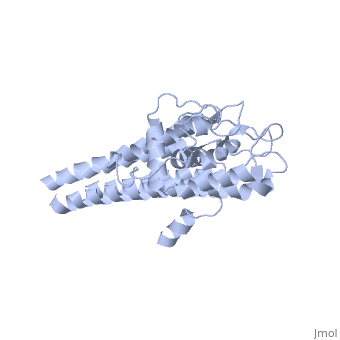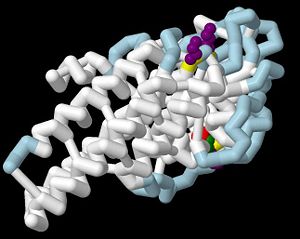Introduction
Borrelia burgdorferi' is a bacterium that is classified under a class of spirochetes of the genus Borrelia. It is the causative agent of Lyme disease, which is a multistage infection that is transmitted by the Ixodes tick. The tick undergoes a 4-stage cycle: egg, larva, nymph, and adult. The tick that is most likely to carry Borrelia burgdorferi is in the nymph stage and it can take from 24 to 48 hours of attachment for the bacteria to transfer to the host[1]. Infection of spirochetes can lead to neurological and cardiovascular infections and arthralgic abnormalities[2].
See also:
The_surface_lipoprotein_E_(VlsE)_of_the_Lyme_disease_spirochete_bacterium
VlsE_of_Borrelia
StudioG24SecL04Tpc5
Found on the surface of the Borrelia burgdorferi is the lipoprotein . VlsE stands for Vmp-like sequence, Expressed, where Vmp is short for variable major protein.[3] It was discovered that VlsE produces a strong antibody response by the immune system, but also has the ability to conceal itself due to an antigenic variation system surrounding the protein. Wrapped by the variable regions are the invariable regions, which are more susceptible to the binding of antibodies. By protecting the more vulnerable regions within the protein it allows the bacteria to manifest in the body without being detected, creating an effective strategy to evade the immune system.
Structural Overview
VlsE is a tetramer that consists of four identical subunits: , B, C, and D. Making up the protein are two invariable regions, found at the N and C terminal regions, and one central variable domain [4][5]. Within the variable domain are six variable (VR) and six invariable regions (IR). Since the N and C terminal regions do not go through constant changes, it was thought they would make great targets for antibodies to attach to. But due to the tightly packed structure of the VlsE and its lateral surface areas binding to other proteins, the terminal regions did not react well with the antibodies. This resulted in low levels of antibody attachment to the surface of the VlsE. Instead, a region within the VlsE that is protected by the antigenic variable system, known as IR6, was found to be the most reactive towards antibodies.
VlsE is composed of 11 alpha helixes, four of which (α1- α3, α11) form a protective layer around the proximal region and the remaining seven helixes (α4- α10) are found in the core of the distal region. The , the only invariable region that was successful in reacting with antibodies of monkeys, mice, and humans, is found on α10. IR6 is found in the core of the distal region and is surrounded by all 6 variable loops of the VlsE. Also present on three major regions of the distal region are amino acids that change their conformation during antigenic variation. The variable system is structured in a way to protect the IR6, which is one of the most susceptible to antibody reaction. The variable loops wrapping the IR6 is quite flexible, but despite its flexibility the IR6 still has very limited surface exposure. Specifically found along the IR6 are the animo residues Lys-276, Gln-279, Lys-291, and Lys-294. These residues found on the ends of the IR6 have been found to have the most interaction with antibodies due to better accessibility.
Immune System Evasion
Antigenic variation is a tactic used by many pathogenic organisms in order to gain a selective advantage over the hosts immune system [6].Specifically the variable domains of VlsE undergo antigenic variation in order to deter antibody recognition during an active humoral response. Cassette exchanges at the membrane distal portion on the surface of the protein contain the amino acid positions that undergo genetic conversion and ultimately change the conformation of random coil structures within [7]. Less than 26% of the primary sequence is located in the [indicated in pink], however, a single substitution of an amino acid residue at these sites are capable of diminishing the recognizable traits of the epitope. An estimated 10^30 combinations of VlsE sequences are possible within a single Borrelia b. infection [8]. Not every variable region undergoes the same sequence change at the same time, some occur more frequently than others. Some positions can stabilize in their new gene sequence while others have a tendency to revert back to the original parental vlsE sequence in a process referred to as sequence reversion [9]. Encompassing 37% of VlsE outer structure, the variable regions are not affected by temperature as suspected but rather the mammalian host cytokine release which provides the signal for the recombinations of genes [10].
Although there is much still to be discovered about the antigenicity of VlsE and gene conversion of the bacterial spirochetes, several theories suggest immunodominance of Borrelia b. exists in the invariable domains embedded inside the variable regions. The location of the IR portion is inaccessible to antibody reactivity, but this does not fully explain its role in immune evasion. In fact, the steric hindrance produced by the overabundance of membrane proteins is the explanatory factor.
Function of Invariable Regions
VlsE consists of 6 invariable regions. These regions are labeled as IR1-IR6.[11] These 6 regions remain constant on VlsE independant of what strain of Borrelia b.[12] This constancy helps determine the structure and physiologic function of VlsE. All invariable regions were found in α helices, specifically α helices 3-10. It is possible that their helix structure causes them to be invariable, and that the fluidity and lack of structure allow for the variable regions. Another thing that the constancy of this region shows is that these areas are possible immune system targets. VlsE is one of the few lipoproteins that has less than 25% of it's primary structure composed of variable components, making more than 75% invariable.
Due to the high amount of invariability it is difficult to comprehend how VlsE remains resistant to the immune system with very little and limited variable region to be altered. Although not proven, it is believed that the IRs are either hidden and not exposed on the surface, or they lack antigenicity. However it has been discovered that IRs are exposed on the molecule's exterior, but are not reachable on the spirochete by antibodies. It is also known that VlsE is hydrophilic meaning that the invariable regions are not concealed, but are most likely inaccessible due to steric hindrance. The most immunodominant invariable region was the IR6. This region is the only α helix that laid perpendicular to the other helices and was embedded within the structure with minimal exposure to the exterior surface.[13]
Diagnostic Testing
Lyme disease presents with symptoms of erythema migrans (EM), arthritis, heart disease, and neurologic abnormalities. If not treated early these symptoms can cause permanent damage to the relative tissues. Using antibiotics, Lyme Disease can be treat and usually cured; however it is hard to diagnose early on and usually goes unnoticed until irreversible symptoms arise. Though, VlsE's function is not known it can be used to diagnose Lyme Disease through invariable region-6. Invariable region-6 (IR6) is important for diagnosis because it is highly reactive to antibody interaction. Although, IR6 has only 13.7% of its surface visible to antibody interactions this is the only site capable for use in human diagnostics.[14] Contained in alpha helix 10 it is composed of 26 peptides, four of which establish antibody adhesion. Amino acids , all contain polar regions that branch out into the extra cellular space. Unlike most residues Lys and Gln side chains can perform a wider range of movements to establish better kinetics with paratopes, permitting higher affinity. Recently these regions have been the target for serodiagnosis using immunoassays. In order to do this, Human blood serum is mixed with detergent to lyse the protein and expose IR6. Western blot and ELISA assays are then used to determine the presents of the pathogen.[15] Depending on the results one or more tests are performed to establish an accurate measure. This procedure is highly expensive nevertheless and is usually performed on patients within Ixode tick infested areas.


